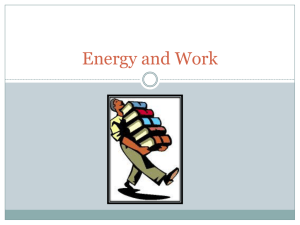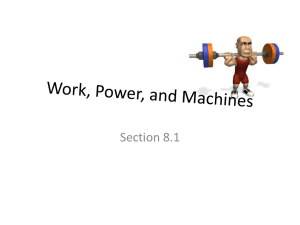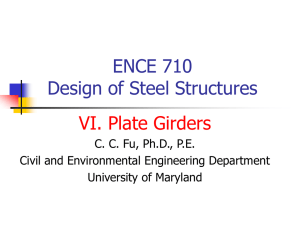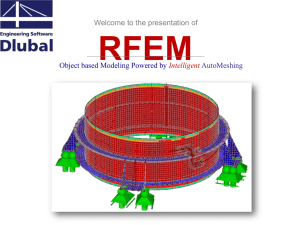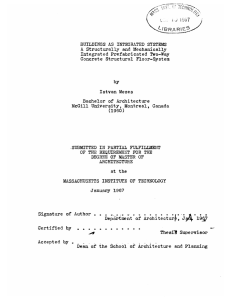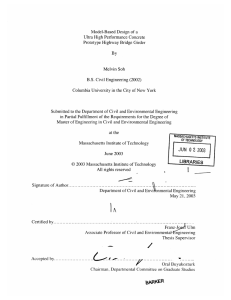Erection & Demolition Stability of Girder Bridges
advertisement
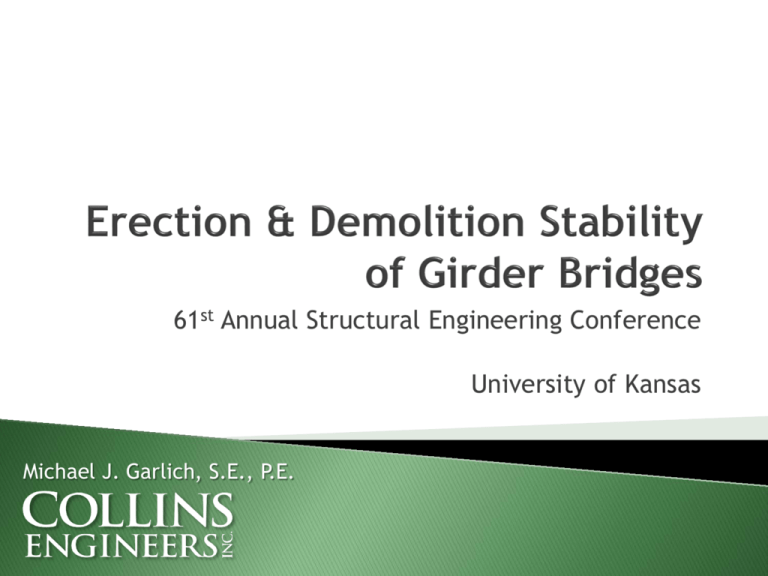
61st Annual Structural Engineering Conference University of Kansas Michael J. Garlich, S.E., P.E. It is unacceptable for bridges to collapse at any time Such events (and near misses) are too common during erection and/or demolition The majority of engineering effort in projects is being placed in design rather than construction There is a general lack of criteria and guidance Stability is a complicated issue Bridge configuration changing Design standards Erection vs. final design Tensile and compressive stresses produced by bending Result: lateral translation and twisting of cross-section – Compression flange buckles & laterally translates – Tension flange doesn’t buckle so shape must twist Vertical Uniform Loading Unbraced Length Timoshenko’s equation for elastic critical buckling moment Mcr (k-in): – Lb = unbraced length (in) = spacing between cross-frames or panel points of lateral truss on comp. flange – E = modulus of elasticity (ksi) – G = shear modulus (ksi) – J = torsional constant (in4) – Cw= warping constant (in6) – Iy = weak-axis moment of inertia (in4) (AASHTO A6.3.3-8) • 1st term under radical: Warping torsional stiffness • 2nd term under radical: Saint-Venant torsional stiffness • Applicable to doubly-symmetric and singly-symmetric shapes Timoshenko’s expression valid for uniform (constant) moment, which is worst case Cb accounts for beneficial moment gradient effect Lateral torsional buckling moment modification factor Cb (AISC Equation) – Cb = 12.5Mmax/(2.5Mmax + 3MA + 4MB + 3MC) Moment gradient increases buckling capacity (Cb ≥ 1) AASHTO LRFD uses different expression – From formulation applicable to straight-line moment diagrams – Variable definitions to approximate non-linear moment diagrams – AASHTO expression in stress, not moment Load distribution – Live load – Wind Girder stability Combined wind and stability Must provide strength and stiffness 0.005 Lb L Mu2 Mbr = (Str) 2 n E Ieff Cb ho βt = 2.4 L Mu2 n E Ieff Cb2 (Stif) Most girder lifts: single crane or spreader beam – Lifting clamp connects to girder top flange – Ideally lifted near girder quarter points – Unbraced length Lb is entire girder length Lift points provide no lateral-torsional restraint a LLift a Buckling behavior of girders during lifting – Moment modification (lift adjustment) factor CbL Function of overhang length relative to total length L CbL = 2.0 for LLIFT/L ≤ 0.225 CbL = 6.0 for 0.225 < LLIFT/L < 0.3 CbL = 4.0 for LLIFT/L ≥ 0.3 Note: unbraced length Lb = total length L Primary source of stability is girder self-weight Crane Lifting Force – Self-weight acts below support point Primary source of instability is lateral-torsional buckling – – – – Long unsupported lengths Overhang region “a” Region between pick points “LLift” Which region controls stability? Depends on locations of pick points Girder Self Weight 6 Horizontally curved girder segments – Can experience rigid body rotation during lifting – Centroid of curved segment may have eccentricity Girder will rotate until… Centroid is below support line – Excessive girder rotation makes air splices difficult – Local rotation / deflection effects Geometry of horizontally curved girders – De-stabilizing moment must be considered during erection – Overturning moment is due to: Offset of center-of-gravity relative to support axis Girder Bottom Flange Plumb Line Dropped from Top Flange- Lateral Deformation = 10 inches Global Buckling (Mcr = 792 k-ft) Buckling Between Cross-Frames (Mcr = 1384 k-ft) 2 SE π Mb = √ Ieff Iy (2 girders, symmetric) Lg2 S = girder spacing ΦMb > 1.5 Mo Non-symmetric; 3- and 4-girder equations available Simply supported—for cantilever and continuous modifier in development Evaluate global and potentially local stability Analysis program can solve for… – Buckling mode shape (eigenvector) – Buckling mode value (eigenvalue) Analysis provides elastic buckling capacity – Material inelasticity is not considered, but… – Stresses during construction in elastic range anyway Most commercial software tools can do eigenvalue buckling Straight bridges Eigenvalue λ: factor applied to reference load This determines critical buckling load Pcr = λPref – Pcr = corresponding buckling load (k) – λ = eigenvalue – Pref = magnitude of applied force (k) Target, Pcr ≥ 1.75 × selfweight Contractor’s preferred erection method Complete 1st splice on ground Erect Span 1 with cantilever portion Case Erected Girders Case 1 5 2 6 3 7 4 8 Erected Girders Eigenvalue analysis of Case 1 (Span 1) – Girder 1 erected with no intermediate bracing Eigenvalue on unfactored selfweight = 0.48 < 1 Buckled shape shown; girder clearly inadequate (LTB) Eigenvalue analysis of Case 2 (Span 1) – Girders 1 & 2 erected with 50% cross-frames Eigenvalue on unfactored selfweight = 1.57 Buckled shape shown; case borderline (1.25<λ<1.75) Contractor’s erection method (continued) Erect Span 2 with air splice Erect remaining cross-frames – 50% of intermediate cross-frames installed originally Evaluate each case’s stability with UT Bridge Eigenvalue analysis using unfactored self-weight Case Eigenvalue 1 0.48 2 1.57 3 1.84 4 1.96 5 1.32 6 2.36 7 3.15 8 3.55 Rollover caused by: – Initial girder rotation compounded by: Lack of flatness of PPC bottom flange Roll flexibility of bearings… Leading to increased girder rotation Note: Figure adapted from Mast (1993) Girder rollover stability can be influenced by: – Bearing slope and bearing type – Bearing skew relative to girder centerline – Girder imperfections (sweep) Rollover controls stability, not lateral-torsional buckling – PPC girders designed to not crack under selfweight – Relatively large Iy and J: no LTB Courtesy of Dr. D. Jauregui Courtesy of Dr. D. Jauregui FHWA developed comprehensive manual and training course Provides: – Summary of lessons learned – Understanding and analysis of global stability – Design criteria for erection – Guidance and best practices – Design examples AASHTO – 300 PLF ASCE 7-10 – F = .00256 kz kzt kd G Cf A V2 – Load factor in velocity ASCE 37 Reduction Factors Cf=2.2 (min) Cf=2(1 + 0.05 s/d) ≤ 4.0 One day, design velocity = 20 mph Velocity modification factors (Vmod=FV) Duration Factor 0 – 6 weeks 0.65 6 weeks – 1 year 0.70 1 year – 2 years 0.8 2 years – 5 years 0.85 Weather Stop-work Equipment issues Load Combinations and Load Factors DC CDL CLL, CR CW Strength I 1.25 1.25 1.75 — Strength III 1.25 1.25 — 1.0 Strength V 1.25 1.5 — 1.0 Strength IV 1.40 1.40 1.50 — Service 1.00 1.00 1.00 1.0
